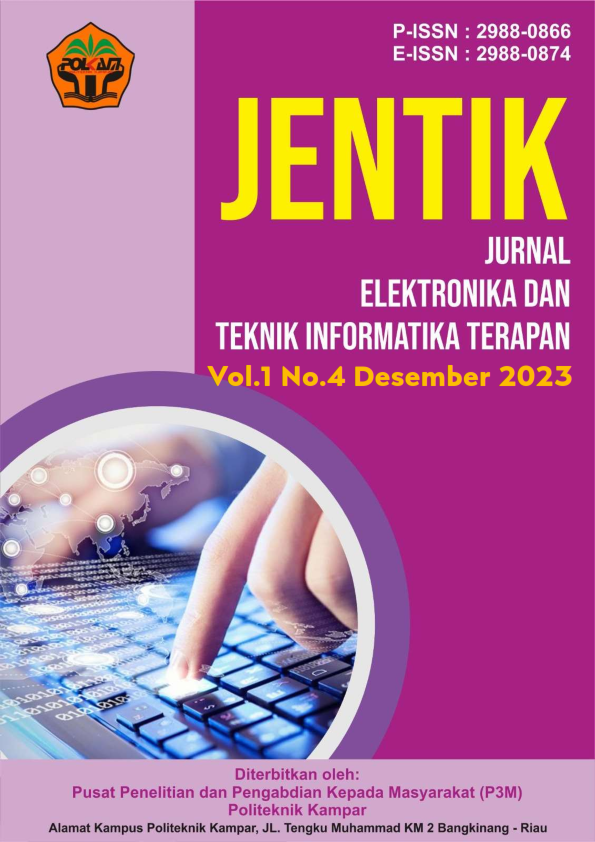Studi Literartur Algoritma Pemograman Pada Pembelajaran Matematika
DOI:
https://doi.org/10.59061/jentik.v1i4.510Keywords:
Program, Algorithm, ProgrammingAbstract
An algorithm is an effective step or method used to solve a particular problem or task. Algorithms are designed to be executed in a methodical manner, structured As it is. logical in this way, thus enabling consistent and efficient problem solving. A few issues that could come up during the process of designing an algorithm include: 1. Inappropriate Structure, .2. Illogical Algorithm, .3. Difficulty in Solving Algorithms: Sometimes, solving algorithms can be difficult, especially if the problem at hand is complex. This can cause confusion and require extra time to design the right algorithm. Programming algorithms typically serve as a guide for computer programmers in designing and implementing software solutions. This algorithm must be clear, systematic, and can be implemented well in the chosen programming language. This research shows that It is crucial to deal with this matter in order to plan and design the algorithm carefully. This may involve modeling the problem, logical thinking, and testing the algorithm to ensure that the algorithm is working as intended. Additionally, in software development, teams often work together to solve problems and optimize algorithms. With good practice and experience, solving algorithms can become more efficient and effective. The following are several types of programming algorithms related to mathematics: 1. Basic Mathematical Operation Algorithms, 2. Search and Sorting Algorithms, 3. Graph Algorithms 4. Geometry Algorithms, 5. Cryptographic Algorithms, 6. Statistical Algorithms, 7. Machine Learning Algorithms, 8. Advanced Mathematical Algorithms. This study uses a library approach and is qualitative.
References
Abidin, Y. (2012). Model penilaian otentik dalam pembelajaran membaca pemahaman beroreintasi pendidikan karakter. Jurnal Pendidikan Karakter, 3(2). 164–178. https://doi.org/10.21831/jpk.v0i2.1301
Chandrawati, sri rahayu. 2010. Pemanfaatan e-learning dalam pembelajaran. No 2 vol. 8. Http://jurnal.untan.ac.id/ .
Conklin, W. (2012). Higher order thinking skills to develop 21st century learners. Shell Education. https://bit.ly/3Pr4WhF
Egereonu, R.A.C. (2010). Analysis of psychomotor domain as a relevant factor in the understanding of mathematical concepts. 19(1), 1–5. https://bit.ly/3NK6Bg7
Garnett, K. (1998). Math learning disabilities. https://bit.ly/3r6qOET
Gowers, T. (2002). The importance of mathematics. Springer. https://bit.ly/44fymDz
Han, S., & Daniel, C. (2014). Construct validation of student attitude toward science, technology, engineering and mathematics project-based learning: The case of Korean middle grade students. Middle Grades Research Journal, 9(3). 27–41. https://bit.ly/3Pw11Aq
Jailani, & Retnawati, H. (2016). The challenges of junior high school mathematic teachers in implementing the problem-based learning for improving the higher-order thinking skills. The Online Journal of Counseling and Education, 5(3), 1–13. https://bit.ly/46nngOP
Kaufman, J. (1981). Mathematics is …. Prindle, Weber & Schmidt. https://bit.ly/3NJxeCO Kele, A., & Shamra, S. (2014). Students' belief about learning mathematics: some findings
from the solomon islands teachers and curriculum, 14(1), 33–44. https://bit.ly/44fD5oN Kilpatrick, J., Jane, S., & Bradford, F. (2001). Adding it up: Helping children learn mathematics. National research council (Ed.). https://bit.ly/46jo9bd
Lampert, M. (2001). Teaching problems and the problems of teaching. In Yale University Press. https://bit.ly/3PvNGYL
Mensah, J., & Okyere, M. (2019). (PDF) Student attitude towards mathematics and performance: Does the teacher attitude matter? Journal of Education and Practice, 4(3), 132–139. https://bit.ly/3XnvGSe
Nasional, D. P. (2006). Permendiknas No. 22 Tahun 2006 tentang standar isi. https://bit.ly/3r50cEg
OECD-FAO. (2015). OECD-FAO agricultural outlook 2015. OECD/FAO. http://dx.doi.org/10.1787/agr_outlook-2015-en
Retnawati, H. (2015). Hambatan guru matematika sekolah menengah pertama dalam menerapkan kurikulum baru (Teachers’ of junior high school in implementation of the new curriculum). Cakrawala Pendidikan, 34(3), 390–403. https://doi.org/10.21831/cp.v3i3.7694
Sullivan, P., & Andrea McDonough. (2007). Eliciting positive student motivation for learning mathematics. Mathematics: Essential Research, Essential Practice 2, 698–707. https://bit.ly/3Jv7lEv
Syamsuddin, S. (2023). Implementasi classic test dan item respon theory pada penilaian tes pembelajaran matematika. EDUSCOPE: Jurnal Pendidikan, Pembelajaran, dan Teknologi, 8(2), 28–43. https://doi.org/10.32764/eduscope.v8i2.3488
Tymoczko, T. (1985). New directions in the philosophy of mathematics. Princeton University Press. https://bit.ly/46lenVU
Utami, & Syamsuddin. (2020). Perubahan perilaku nomophobia melalui pendekatan interaksi sosial: Sngle case research (SCR). Preschool: Jurnal Perkembangan dan Pendidikan anak usia dini, 2(1), 133–140. https://bit.ly/46na0JX
Wahyudi, Suyitno, H., & Waluya, B. S. (2018). Dampak perubahan paradigma baru matematika terhadap kurikulum dan pembelajaran matematika di Indonesia. Jurnal Ilmiah Kependidikan, 1(1), 38–47. https://doi.org/10.24176/jino.v1i1.2315
Downloads
Published
How to Cite
Issue
Section
License
Copyright (c) 2023 Jurnal Elektronika dan Teknik Informatika Terapan

This work is licensed under a Creative Commons Attribution-NonCommercial-ShareAlike 4.0 International License.






